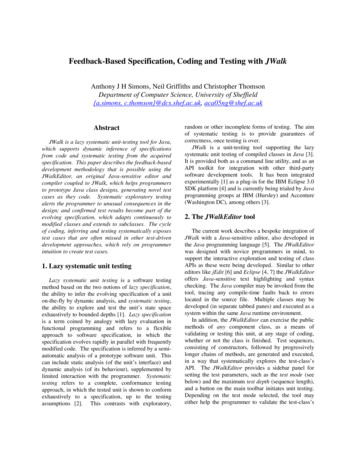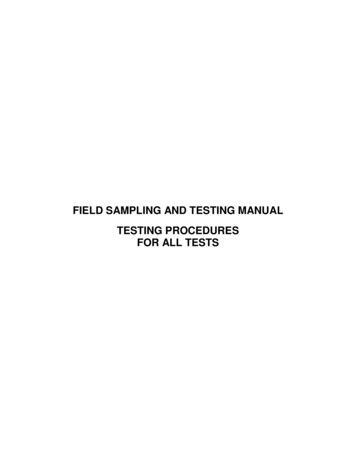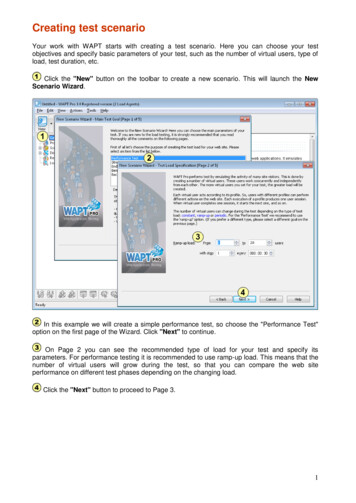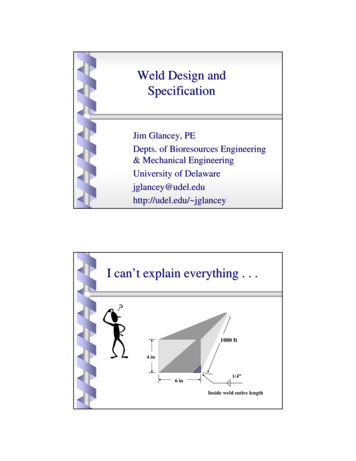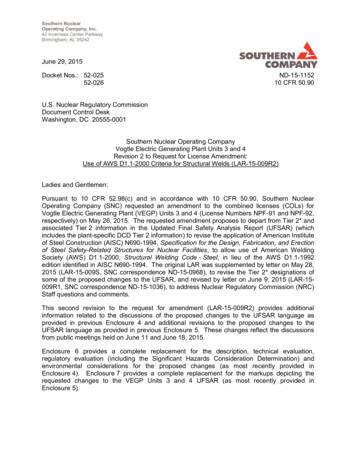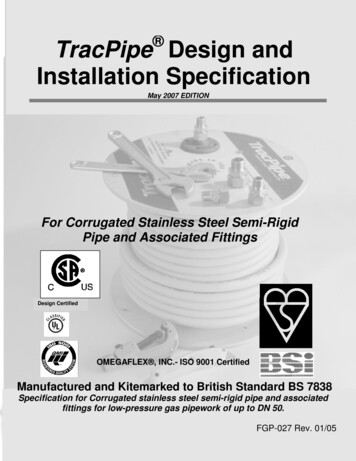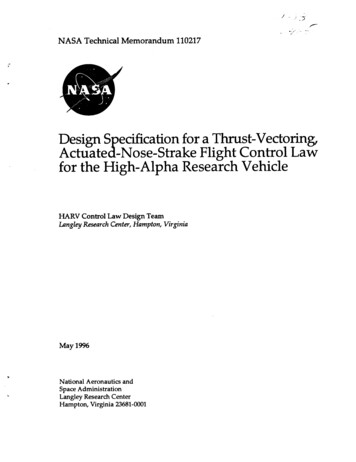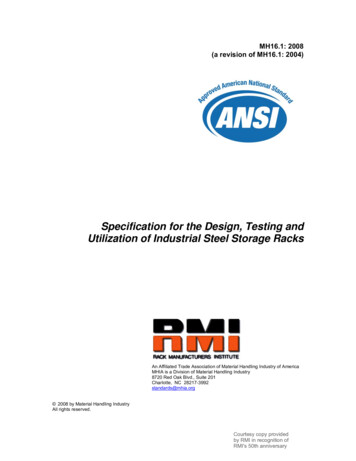
Transcription
MH16.1: 2008(a revision of MH16.1: 2004)Specification for the Design, Testing andUtilization of Industrial Steel Storage RacksAn Affiliated Trade Association of Material Handling Industry of AmericaMHIA is a Division of Material Handling Industry8720 Red Oak Blvd., Suite 201Charlotte, NC 28217-3992standards@mhia.org 2008 by Material Handling IndustryAll rights reserved.Courtesy copy providedby RMI in recognition ofRMI's 50th anniversary
American National StandardApproval of an American National Standard requires verification by ANSI that the requirementsfor due process, consensus, and other criteria for approval have been met by the standardsdeveloper.Consensus is established when, in the judgment of the ANSI Board of Standards Review,substantial agreement has been reached by directly and materially affected interests. Substantialagreement means much more than a simple majority, but not necessarily unanimity. Consensusrequires that all views and objections be considered, and that a concerted effort be made towardtheir resolution.The use of American National Standards is completely voluntary; their existence does not in anyrespect preclude anyone, whether he has approved the standards or not, from manufacturing,marketing, purchasing, or using products, processes or procedures not conforming to thestandards.The American National Standards Institute does not develop standards and will in nocircumstances give an interpretation of any American National Standard. Moreover, no personshall have the right or authority to issue an interpretation of an American National Standard in thename of the American National Standards Institute. Requests for interpretations should beaddressed to the sponsor whose name appears on the title page of this standard.CAUTION NOTICE: This American National Standard may be revised or withdrawn at any time.The procedures of the American National Standards Institute require that action be takenperiodically to reaffirm, revise or withdraw this standard. Purchasers of American NationalStandards may receive current information on all standards by calling or writing the AmericanNational Standards Institute.Published byRack Manufacturers InstituteAn Affiliated Trade Association of Material Handling Industry of America (MHIA),MHIA is a division of Material Handling Industry8720 Red Oak Blvd., Suite 201, Charlotte, NC, 28217-3992Telephone: (704) 676-1190www.mhia.org/rmistandards@mhia.org 2008 by Material Handling IndustryAll rights reserved.No part of this publication may be reproduced in any form,in an electronic retrieval system or otherwise, withoutprior written permission of the publisher, RMI.Printed in the United States of America.Courtesy copy providedby RMI in recognition ofRMI's 50th anniversary
MH16.1: 2008(a revision of MH16.1: 2004)American National StandardSpecification for the Design, Testing andUtilization of Industrial Steel Storage RacksRack Manufacturers Institute (RMI)An Affiliated Trade Association of Material Handling Industry of America (MHIA),MHIA is a Division of Material Handling IndustryApproved April 21, 2008American National Standards Institute, Inc.Courtesy copy providedby RMI in recognition ofRMI's 50th anniversary
American National StandardMH16.1: 2008 (a revision of MH16.1: 2004)Specification for the Design, Testing andUtilization of Industrial Steel Storage RacksDisclaimerThis standard, which was developed under Material Handling Industry procedures,represents suggested design practices and performance testing criteria for industrial steelstorage racks. It was developed with the sole intent of offering information to partiesengaged in the manufacture, marketing, purchase, or use of industrial steel storage racks.This standard is advisory only and acceptance is voluntary and the standard should beregarded as a guide that the user may or may not choose to adopt, modify, or reject. Theinformation does not constitute a comprehensive safety program and should not be reliedupon as such. Such a program should be developed and an independent safety adviserconsulted to do so.The acceptance or use of this specification is completely voluntary. Its existence does not inany respect preclude anyone, whether the specification has been approved or not, frommanufacturing, marketing, purchasing, or using products, processes, or procedures notconforming to this specification.Material Handling Industry (MHI), Rack Manufacturers Institute (RMI) and their membersassume no responsibility and disclaim all liability of any kind, however arising, as a result ofacceptance or use or alleged use of this standard. User specifically understands and agreesthat MHI, RMI and their officers, agents, and employees shall not be liable under any legaltheory or any kind for any action or failure to act with respect to the design, erection,installation, manufacture, preparation for sale, sale, characteristics, features, or delivery ofanything covered by this standard. Any use of this information must be determined by theuser to be in accordance with applicable federal, state, and local laws and regulations.MHI and RMI make no warranties of any kind, express, implied, or statutory, in connectionwith the information in this standard. MHI and RMI specifically disclaim all implied warrantiesof merchantability or of fitness for particular purpose.By referring to or otherwise employing this standard, the user agrees to defend, protect,indemnify, and hold MHI and RMI and their officers, agents, and employees harmless fromand against all claims, losses, expenses, damages, and liabilities, direct, incidental, orconsequential, arising from acceptance or use or alleged use of this standard, including lossof profits and reasonable attorneys' fees which may arise out of the acceptance or use oralleged use of this standard. The intent of this provision and of the user is to absolve andprotect MHI and RMI and their officers, agents, and employees from any and all loss relatingin any way to this standard, including those resulting from the user's own negligence.iCourtesy copy providedby RMI in recognition ofRMI's 50th anniversary
American National StandardForewordMH16.1: 2008 (a revision of MH16.1: 2004)Specification for the Design, Testing andUtilization of Industrial Steel Storage Racks(This foreword is not part of American National Standard MH16.1:2008)RACK MANUFACTURERS INSTITUTEThe Rack Manufacturers Institute (RMI) is an independent incorporated trade associationaffiliated with the Material Handling Industry. The membership of RMI is made up ofcompanies which produce the preponderance of industrial steel storage racks. Thisspecification is the result of RMI’s recognition of the need to develop a comprehensive safetyspecification and establish minimum design and performance criteria to ensure the safeapplication and utilization of racking, and was formulated under American National StandardsInstitute (ANSI) procedures.At the date of approval of this specification, RMI consisted of the following membercompanies:Adrian Fabricators, Inc./CargotainerAdvance Storage Products, Div. of J.C.M. Industries Inc.Atlas Material Handling, Inc.AWP Industries, Inc./American Wire ProductsBase ManufacturingBITO Lagertechnik Bittmann GmbHBulldog Rack CompanyEngineered ProductsExcel Storage Products, LPFrazier IndustrialHannibal Material Handling, Inc.ITCJ&L Wire Cloth LLCKonstantLodi Metal Tech, Inc.Mecalux USA, Inc.Morgan Marshall Division, A Leggett & Platt CompanyNashville Wire Products Manufacturing Co., Inc.Nedcon USA Inc.Ridg-U-Rak, Inc.SpaceRak, Division of TarponSpeedrack Products Group, Ltd.Steel King Industries, Inc.Unarco Material Handling, Inc.United Fixtures InterlakeWireway Husky CorporationRMI maintains a public website at www.MHIA.org/RMI that has information about storageracks and the RMI members including ordering information for literature and a section forfrequently asked questions. All inquiries concerning the Specification should be directed inwriting to the RMI Engineering Committee, 8720 Red Oak Boulevard, Suite 201, Charlotte,NC 28217MATERIAL HANDLING INDUSTRYThe Material Handling Industry (Industry) provides RMI with certain services and, inconnection with this Specification, arranges for its production and distribution. Neither theMaterial Handling Industry nor its officers, directors, or employees have any otherparticipation in the development and preparation of the information contained in theSpecification.iiCourtesy copy providedby RMI in recognition ofRMI's 50th anniversary
American National StandardMH16.1: 2008 (a revision of MH16.1: 2004)Specification for the Design, Testing andUtilization of Industrial Steel Storage RacksSPECIFICATION - HISTORYIn the interest of improved uniformity of rack performance and enhanced public safety, theRMI published in 1964 its first “Minimum Engineering Standards for Industrial StorageRacks.” and now publishes this Specification. It was developed and promulgated by the RMIwith the sole intent of offering information to the parties engaged in the engineering,manufacturing, marketing, purchasing, installation or use of such racks.Since 1964, mechanized storage systems have grown very rapidly both in size and heightwith new and modified types of racks having been developed. To reflect this rapiddevelopment and to assure adequate safety and performance of modern rack structures, theRMI decided early in 1971 to replace its original standards by a more detailed andcomprehensive specification. Professors George Winter and Teoman Pekoz of CornellUniversity were retained to assist the Rack Standard Development Project Committee inproducing such a document. The members of the Material Handling Institute, Inc. were thesponsors.In 1972, the “Interim Specification for the Design, Testing and Utilization of Industrial SteelStorage Racks” was adopted by the Rack Manufacturers Institute at their annual fall meeting.The specification was then submitted to the American National Standards Institute for theirreview and acceptance. In 1974, the Interim Specification with minor changes was acceptedas American National Standard ANSI MH 16.1: 1974.The Rack Manufacturers Institute together with its sponsors from the Material HandlingInstitute, Inc., retained Professors Winter and Pekoz to continue testing rack componentsplus perform full scale tests on typical storage rack structures. A number of the test resultshave been analyzed, and it was considered necessary to rewrite the 1972 InterimSpecification to include the knowledge gained from the analysis of those tests. The 1972Interim Specification was rewritten by the Rack Standards Subcommittee with the assistanceof Professors Winter and Pekoz. Design parameters relating to drive-in and drive-throughracks have been removed from the Specification until drive-in and drive-through rack testresults could be analyzed more thoroughly; perhaps more testing would be required.Movable-shelf racks were added to the Specification.As a result of additional testing and analytical research, the RMI revised the 1972Specification. The ANSI MH 16.1: 1974 was withdrawn in deference to the 1979Specification. More additions and revisions prompted the RMI to publish the 1985Specification.Subsequent testing and research by Dr. Pekoz was the basis of the changes resulting in the1990 Specification.From 1990 to 1997, due to continuing changes, specifically as they relate to seismic analysisand other model building code issues, the Specification Advisory Committee, the SeismologyCommittee and the RMI Engineering Committee working again with Dr. Pekoz and severalhighly regarded members of the code community and various other members of similargroups throughout the world, conducted extensive testing and parametric analysis. Findingsresulted in the 1997 Specification.In addition to the state-of-the-art benefit from the ongoing testing and analysis, the 1997Specification was expanded to include complete treatment of seismic design considerationsso that the Specification could be more easily incorporated by reference into various modelbuilding and design codes.iiiCourtesy copy providedby RMI in recognition ofRMI's 50th anniversary
American National StandardMH16.1: 2008 (a revision of MH16.1: 2004)Specification for the Design, Testing andUtilization of Industrial Steel Storage RacksIn 1999, the Membership of RMI acted to create a Voluntary Certification Program known asthe R-MARK. The R-Mark is a license earned by a manufacturer following a rigorous reviewby Independent Professional Engineers of tests and load capacity calculations performed bythe manufacturer consistent with the RMI/ANSI Specification.Continued testing and parametric studies resulted in the 2002 Specification. In 2004 the2002 RMI Specification and Commentary were adopted as American National StandardANSI MH 16.1-2004SPECIFICATION - 2008 EDITIONThe use of this Specification is permissive, not mandatory. Voluntary use is within the controland discretion of the user and is not intended to, and does not in any way limit the ingenuity,responsibility or prerogative of individual manufacturers to design or produce industrial steelstorage racks that do not comply with this Specification. RMI has no legal authority to requireor enforce compliance with the Specification. This advisory Specification provides technicalguidelines to the user for his specific application. Following the Specification does not assurecompliance with applicable federal, state, or local regulations and codes. This Specificationis not binding on any person and does not have the effect of law.The RMI and the Material Handling Industry do not take any position regarding any patentrights or copyrights which could be asserted with regard to this Specification and does notundertake to insure anyone using this Specification against liability, nor assume any suchliability. Users of this Specification are expressly advised that determination
American National Standard MH16.1: 2008 (a revision of MH16.1: 2004) Specification for the Design, Testing and Utilization of Industrial Steel Storage Racks iv In 1999, the Membership of RMI acted to create a Voluntary Certification Program known as the R-MARK. The R-Mark is a license earned by a manufacturer following a rigorous reviewFile Size: 1MBPage Count: 126
